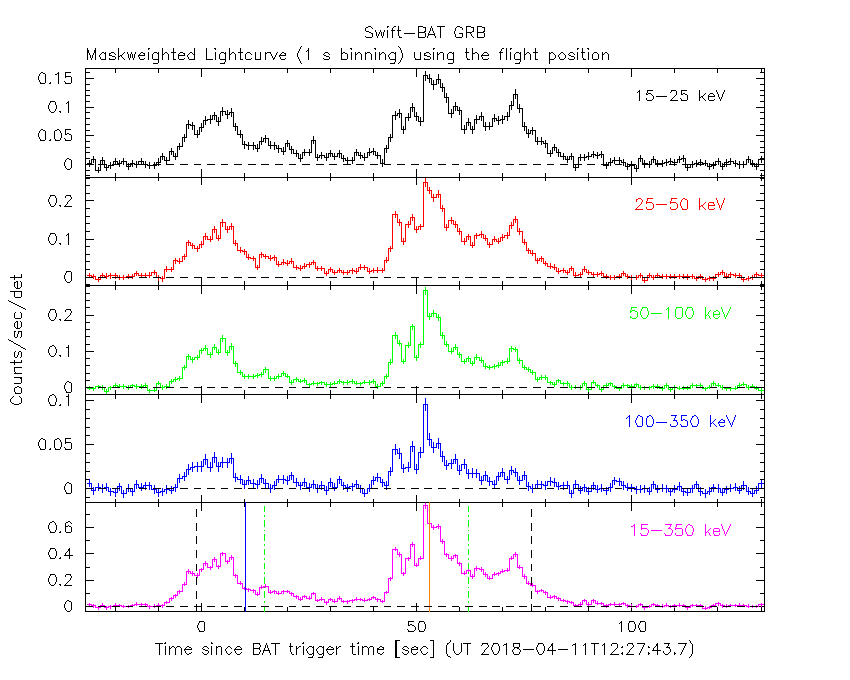
Z. Liu (NAOC/U. Leicester), S.L. Gibson (U. Leicester) and A.A. Breeveld (UCL-MSSL) for the Swift team
At 12:27:43 UT, the Swift Burst Alert Telescope (BAT) triggered and located GRB 180411A (trigger=824451) (Liu et al. GCN Circ. 22630). Swift slewed immediately to the burst. At the time of the trigger, the initial BAT position was 61° from the Sun (1.5 hours West) and 83° from the 21%-illuminated Moon. Table 1 contains the best reported positions from Swift, and the latest XRT position can be viewed at http://www.swift.ac.uk/xrt_positions.
Table 2 is a summary of GCN Circulars about this GRB from observatories other than Swift.
Standard analysis products for this burst are available at https://gcn.gsfc.nasa.gov/swift_gnd_ana.html.
Analysis of the BAT data was reported by Markwardt et al. (GCN Circ. 22633).
Liu, et al., GCN Circ. 22630).
The BAT ground-calculated position is RA, Dec = 356.840, 66.790 deg, which is RA(J2000) = 2
The mask-weighted light curve (Figure 1) show two major episodes of overlapping peaks with the first starting at ~T-15 s, peaking at ~T+5 s, and second episode starting at ~T+42 s, peaking at ~T+52 s, and returning to zero ~T+180 s.
The time-averaged spectrum from T-7.02 to T+92.38 s is best fit by a simple power-law model.
The power law index of the time-averaged spectrum is 1.46 ± 0.03.
The fluence in the 15-150 keV band is 1.2 ± 0.0 x 1
The results of the batgrbproduct analysis are available at https://gcn.gsfc.nasa.gov/notices_s/824451/BA/.
Analysis of the initial XRT data was reported by Gibson et al. (GCN Circ. 22632). We have analysed 22 ks of XRT data for GRB 180411A, from 72 s to 74.3 ks after the BAT trigger. The data comprise 200 s in Windowed Timing (WT) mode with the remainder in Photon Counting (PC) mode.
The late-time light curve (Figure 2) (from T0+4.4 ks) can be modelled with an initial power-law decay with an index of α=1.14 (+0.05, -0.17), followed by a break at T+55.0 ks to an α of 3.6 (+3.9, -2.2).
A spectrum formed from the WT mode data can be fitted with an absorbed power-law with a photon spectral index of 1.68 ± 0.10. The best-fitting absorption column is 1.54 (+0.16, -0.15) x 1
A summary of the PC-mode spectrum is thus:
Total column: 1.80 (+0.22, -0.20) x 1
Galactic foreground: 8.3 x 1
Excess significance: 7.9 σ
Photon index: 1.98 (+0.15, -0.14)
The results of the XRT team automatic analysis are available at http://www.swift.ac.uk/xrt_products/00824451.
The Swift/UVOT began observations of the field of GRB 180411A 64 s after the BAT trigger with a settling exposure in the V filter
(Breeveld and Liu GCN Circ. 22638).
The UVOT safety circuit tripped 3.4s into the following UV grism exposure, most likely due to the bright star HD223128, 5.08 arcmin from the burst position.
Table 3 gives preliminary
magnitudes using the UVOT photometric system
(Breeveld et al. 2011, AIP Conf. Proc., 1358, 373).
No correction has been made for the expected extinction in the Milky Way
corresponding to a reddening of

Figure 1. The BAT
mask-weighted light curve in the four individual and total
energy bands. The units are counts

Figure 2. The XRT light curve.
Any data from a crosshatched region are not included in the fit.
| RA (J2000) | Dec (J2000) | Error | Note | Reference |
|---|---|---|---|---|
| 2 |
+66°46'42.5" | 3.5" | XRT-final | UKSSDC |
| 2 |
+66°46'42.5" | 3.5" | XRT-refined | Gibson et al. GCN Circ. 22632 |
| 2 |
+66°47'25.2" | 1.0' | BAT-refined | Markwardt et al. GCN Circ. 22633 |
| Band | Authors | GCN Circ. | Subject | Observatory | Notes |
|---|---|---|---|---|---|
| Optical | Stecklum et al. | 22637 | Tautenburg observations | Tautenburg | |
| Gamma-ray | Poolakkil et al. | 22634 | Fermi GBM detection | Fermi GBM | Fluence=3.276±0.085x1 (9 |
| Gamma-ray | Frederiks et al. | 22639 | Konus-Wind observation | Konus-Wind | |
| Gamma-ray | Frederiks et al. | 22640 | Konus-Wind observation | Konus-Wind | |
| Gamma-ray | Pal'shin et al. | 22642 | CALET Gamma-Ray Burst Monitor detection | CALET |
Table 3. Found no UVOT observations.
April 13, 2018